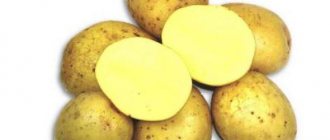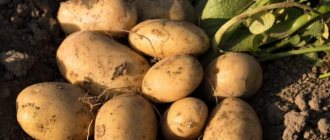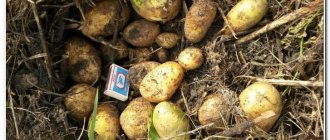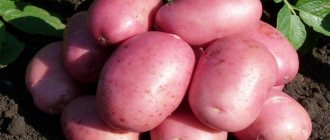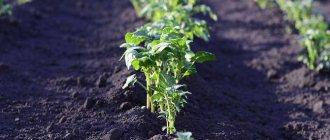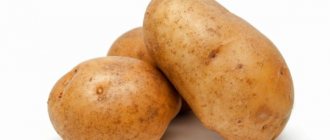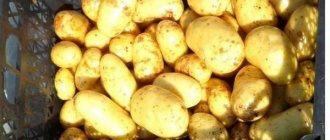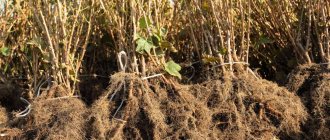What kind of potatoes are these?
The Vega potato variety belongs to the table type and is characterized by early ripening and high fruiting rates.
Origin and development
The homeland of the Vega potato is Germany . German specialists worked hard to create a new crop, resulting in a high-yielding and early-ripening variety, which over time gained popularity not only in the West, but also in Russia, Belarus and Ukraine.
The culture was included in the State Register of the Russian Federation in 2013. Despite its short lifespan, the variety is known to many gardeners in all regions.
This is interesting! Due to the potato's worldwide fame and invaluable contribution to the food industry, a Museum dedicated to this vegetable has been opened in Belgium. It contains many exhibits, including paintings by famous artists.
Distinctive features, characteristics of the variety
The average weight of ripe root vegetables is 90-130 g, oval in shape . The peel is light yellow with barely noticeable small eyes. The thickness of the skin is average, it is quite durable, so vegetables have increased shelf life. Harvest safety is up to 99% of the total mass.
The pulp is light in color, closer to lemon , which does not darken during heat treatment. The taste quality is high, making potatoes suitable for preparing any dish, as well as chips, frozen vegetable mixtures and fast foods.
The purpose of ripe vegetables is table . The starch content ranges from 10-15%. Its formation is influenced by soil composition. The more nutritious the soil, the higher the starch content.
Description of the plant
Bush of medium height, erect . The leaves are rich green, medium-sized, moderate foliage. When flowering, neat white flowers with a cream tint are formed.
The culture is resistant to long-term drought and perfectly adapts to short-term cold snaps . The ripening period is early, harvesting begins 60-70 days after planting.
Plants are endowed with lasting immunity to potato canker, golden nematode and potato mosaic virus. But the crop has average resistance to late blight.
About other potato varieties:
Unpretentious and highly productive El Mundo potatoes
Mid-early potatoes "Laura" with excellent taste and aroma
Domestic potatoes "Aurora" for a rich harvest
Productivity
Vega potatoes are ideal for cultivation on an industrial scale and are in demand among entrepreneurial farmers. The average yield is 250-300 c/ha. But with proper care and fertile soil, the indicators increase to 450 c/ha.
At least 8 large potatoes are formed on 1 seedling . All root vegetables are almost the same size, aligned.
Growing
Inventory
Some gardeners have already mechanized their work and use a special garden planter or walk-behind tractor to plant potatoes. But in small areas, the traditional manual planting method and proven garden tools are used:
- bayonet shovel;
- hoe;
- rake;
- pitchfork;
- hand hoe;
- shovel for digging up the garden and digging potatoes.
Soil preparation
The Vega variety grows best in light and fertile soil. Soil fertilization is done in the fall. They scatter manure around the area and then dig it up thoroughly. Cultivation is carried out in the spring in warm weather immediately before planting potatoes.
Preparation of planting material
For planting, select tubers of small size, approximately the size of a chicken egg, without signs of disease, severe damage, regular shape and uniform color.
A few weeks before planting, these potatoes are laid out in wooden boxes in layers of 2-3 tubers. For good air circulation, the boxes must have gaps between the boards. The room temperature should be at least 15-17°C with average humidity. If the air is very dry, the planting material is sprayed with water several times a day.
Important!
To increase the number of eyes, simultaneous germination of tubers and increase yield, hardening of planting material is necessary. To do this, lower the temperature by 6-8°C once a day for a few minutes.
The room should be bright. Tubers are considered ready for planting if several gray-white shoots with a thickness of 3 mm and a length of at least 2 cm have formed on them.
Boarding time
Depending on the growing region, potato planting begins from late April to mid-May. The main reference point is the soil temperature. The soil should warm up to a temperature of + 8-10°C.
Scheme
- Holes are dug to a depth of 10-15 cm; for northern regions, 20 cm is possible.
- The distance between the holes should be at least 30 cm, and the row spacing should be 60-70 cm.
- To improve productivity, 50 g of humus, wood ash or saltpeter can be placed at the bottom of the hole.
- The tubers are placed sprouts up and covered with a small hill of earth.
- The soil is not compacted so as not to damage the shoots.
Care
Vega potatoes do not require special care. It is necessary to follow the rules that gardeners use to grow any type of potato and take into account some of the features of the Vega hybrid.
Hilling
Attention!
Experts have found that if hilling is not carried out, the yield is reduced by 20%.
Indeed, with this type of work we not only reduce the spreading of the bush, but also clear the soil of weeds. Therefore, it is necessary to hill up at least twice a season. The first time is when the sprouts have just appeared and the second time when the height of the tops reaches 15 cm.
Watering
A special feature of the Vega variety is its sensitivity to watering. In order for the soil to be evenly moistened to a depth of 40-45 cm, not frequent but abundant watering is necessary. Some experts recommend starting to water potatoes when the tops grow to 10 cm and stop immediately after flowering. In summer, one or two waterings per week are enough, but drip irrigation solves all problems.
Weeding
In terms of the structure of the root system, potatoes are inferior to many weeds. Therefore, they not only take away nutrients and moisture, but can also destroy the tuber. Weeding is done twice a season. The first time is when the stems just emerge from the ground, the second time is before flowering. Therefore, it is better to combine weeding with hilling.
Top dressing
To increase the yield, it is advisable to fertilize the plants twice a season. Ammonium nitrate or urea is used during the formation of tubers and abundant growth of the bush, but after flowering and before the tops wither, mineral fertilizers are applied.
Other care measures
In very hot seasons, which the Vega variety tolerates normally, it is possible to mulch the beds to avoid severe drying out of the soil. For this, it is better to use organic substances rather than film. Mulching with straw will not only retain moisture in the soil, but will eliminate the need for weeding, limiting the spread of annual weeds.
How to grow potatoes
The quality of the finished product is influenced not only by proper care during the growing season , but also by pre-sowing treatment of seed material. If you follow the necessary and simple rules, a rich and tasty harvest is guaranteed.
Pre-sowing preparation
For planting material, select tubers no more than 100 g (the size of a chicken egg). They are carefully examined and only healthy ones are left, without visible damage and unchanged in color.
The preparation of tubers begins 1 month before sowing in the ground . Selected potatoes are laid out in a bright room for germination. The temperature is maintained at +15°C. Within a month, the sprouts on the tubers grow to 1.5-2 cm.
Immediately before planting, the seed is treated with a weak solution of potassium permanganate or the drug “Fitosporin” for disinfection purposes.
Reference! To increase immunity, 1 week before sowing, potatoes are taken outside for 1 hour. This procedure is called hardening and helps to strengthen the immunity of plants and more quickly adapt to outdoor conditions.
Timing, scheme and technology of planting
Planting in the ground begins in late April or early May . The final dates will be determined by the climatic conditions of the region. The daytime air temperature should remain at +17…+19°C, and the minimum soil temperature +9°C.
The soil chosen is light and fertile . For lightness, river sand or peat is added to it.
The soil is prepared in the fall, dug up and humus and wood ash are added for fertility.
Planting pattern : 35 cm – distance between seedlings, 70 cm left between rows. The depth of the holes is no more than 15 cm. A little wood ash is placed at the bottom of each and filled with water. After planting, the tubers are covered with soil and slightly moistened.
Reference! Many gardeners focus on birch leaves. As soon as the first leaves bloom, you can start planting.
Further care
Caring for the variety does not involve any complex procedures . All agricultural practices come down to standard cultivation rules, namely: watering, loosening, weeding and hilling.
The main thing is to maintain the regime and avoid excess or lack of moisture. Although the crop is adapted to long-term drought, you should not abuse this feature if you want to get tasty, marketable tubers.
Watering
The plantings are watered for the first time when the seedlings reach a height of 10 cm . Before this, irrigate only when the soil is very dry. In the future, water infrequently, but abundantly. Be sure to control the humidity level in the beds. This is especially important for all plants susceptible to fungal diseases.
After watering, loosening is carried out . Access to oxygen to the root system is necessary for the full growth of bushes and strengthening their immunity. During loosening, weeding is carried out, removing all weeds with roots so that they do not interfere with the healthy growth of seedlings.
Advice! The use of drip irrigation eliminates increased levels of humidity in the beds: water is supplied exclusively to the roots of the seedlings and does not stagnate in the soil.
Hilling up is no less important a procedure than watering or loosening . Promotes the formation of new roots, which has a beneficial effect on fruiting. Plants are hilled three times a season, raking the soil from the rows onto the bushes with a hoe. In addition, hilling protects the tubers from exposure to sunlight.
Feeding
Seedlings are fed at least 2 times per season . During the growth and formation of root crops, organic compounds, such as urea, are used as fertilizers.
During the flowering period and at the time of fruiting, the crop is fertilized with a complete mineral complex with a predominant content of potassium and phosphorus.
If the bushes grow poorly after replanting , nitrogenous substances are used to help the plants grow green mass.
Reference! Any fertilizing is applied after abundant watering.
Disease and pest control
Late blight is the most serious disease for nightshade crops , difficult to treat. Compliance with planting technology and pre-sowing treatment is a mandatory and important preventive measure.
With a sufficient distance from each other, the seedlings will be ventilated and receive the required amount of light. With moderate watering, the humidity level will not be exceeded, which means the risk of developing fungal spores will be reduced.
Another important and necessary measure in the fight against late blight is compliance with crop rotation rules. Potatoes are not planted in the same beds where peppers, eggplants and tomatoes used to grow. The best predecessors are greens and legumes. After them, the soil retains fertility, being saturated with nitrogen.
When carrying out the prevention of fungal diseases, do not forget about insect pests , from which seedlings suffer no less than from diseases:
- The Colorado potato beetle is capable of destroying plantings in a few days. In addition to adults, larvae are dangerous for plants. When inspecting bushes, it is important to turn over the leaves, otherwise the larvae will go unnoticed. In case of mass damage, the insecticide “Prestige” is used. If the quantity is small, the beetle and larvae are collected by hand.
- The wireworm lives in the soil and attacks root crops, which subsequently rot in the ground. Digging the soil in the fall and before spring planting is an effective preventive measure in the fight against the pest. Also, the wireworm does not tolerate mustard, so when planting tubers, it is enough to pour a little mustard powder into the holes.
Landing
The Vega potato variety does not require special agrotechnical skills, as it easily tolerates temperature fluctuations and changes in humidity. Experienced vegetable growers recommend pre-germinating the tubers and then warming them up.
- Choose healthy tubers with a smooth surface and no signs of disease.
- Install special shelving structures or containers in a well-lit room where the air temperature is from 15 to 17˚ C.
- Place the potatoes in layers on the prepared area.
- In order for the tubers to germinate evenly, it is necessary to rearrange the boxes from time to time.
The first shoots appear after 21 days. You should also harden the sprouted tubers; for this you need to periodically change the temperature conditions sharply (a decrease of 6-8˚ C). This method promotes the activation of gosta eyes and is a guarantee of simultaneous germination of tubers and a high yield.
Soil preparation
Qualitative indicators of the yield of Vega potatoes are observed when planting sprouted tubers on light sandy soils. For effective fruiting, the soil must be properly prepared.
Features of site preparation:
- Choose a dry place to plant tubers.
- Loosen the soil.
- Pour a small amount of wood ash and compost substrate into each hole.
The soil needs to be properly prepared
Such cereal herbs will help enrich the soil with useful microelements during the process of their own decay. In some cases, it is also possible to use ready-made fertilizer solutions for nightshade crops. In autumn, the soil should not be broken into clods. Large soil fractions will freeze better in winter, and along with them most of the weed seeds will be destroyed.
Planting
The characteristics of Vega potatoes imply mid-early planting of sprouted tubers - late April or early May. At this time, the soil warms up well, which promotes further effective growth of tubers.
- Reject tubers without sprouts or with sluggish thin sprouts, as well as small potatoes weighing less than 30 g.
- Planting depth – 10-12 cm.
- Dig holes in increments of 35 to 38 cm.
- The distance between rows is from 70 to 75 cm.
- Place the tubers in the holes and cover them with fertile soil.
The growing season of this varietal variety ranges from 60 to 69 days. According to reviews from experienced vegetable growers, there is no need to water after planting tubers.
During the entire growing season, it is recommended to hill up the bushes at least twice. It is also necessary to ensure that weeds do not spread; for this you need to regularly weed the plants.
Weed control can be done manually. It is also possible to use herbicides, which are an effective way to kill weeds.
Watering
Vega potatoes are very sensitive to watering, so it is recommended to moisten the soil infrequently but generously. To get a high yield, moisture must saturate the soil to 40-45 cm.
The optimal solution to ensure proper watering is the drip irrigation method. Using this method of moistening, moisture will flow directly to the tubers, which will have a positive effect on yield.
Fertilizer
Throughout the growing season, potatoes should be fertilized; it is recommended to carry out two feedings. During the first feeding during the development of tops and the formation of tuber groups, ammonium nitrate or a weak urea solution is used.
During the second feeding, potassium sulfate or superphosphate fertilizers are used. Also, after the flowers have appeared and before the initial stage of withering of the tops, mineral fertilizers should be applied. No further fertilization is required.
Pest treatment
This variety needs treatment for pests. When plants are damaged by the Colorado potato beetle, various control methods are used, including mechanical destruction of pests after manual assembly.
Bushes are treated with the following solutions:
- chemicals Sonnet, Regent;
- herbal tinctures of celandine and acacia.
Also, some gardeners dust the bushes. To do this, pour wood ash into a bucket and use a broom to sprinkle all the bushes, even those that do not have Colorado potato beetles. Dusting can be done using a regular sieve.
Collection, storage and use of crops
The crop is dug up with a shovel or pitchfork. Thick skin reduces the risk of mechanical damage to root crops. Dig potatoes as soon as the foliage begins to fade . After harvesting, the tubers are laid out to dry in the sun for several hours.
Before storing vegetables for long-term storage , they are carefully inspected and spoiled ones are disposed of. Potatoes are placed in wooden boxes and left in a cool, dry room.
Vega has a high shelf life , so the tubers retain their presentation and taste until spring. Long-term transportation also does not affect the safety of the finished product.
Ripe vegetables have a universal purpose and are used not only in private households, but also in large-scale industries . They are used to prepare chips, semi-finished products and fast food. Potatoes are also readily purchased by restaurant chains. In households, all kinds of dishes are prepared from Vega, which are distinguished by their rich taste and pleasant color.
Features of cultivation
The Vega variety prefers light sandy soils. Before planting, the soil is thoroughly loosened and compost or wood ash (preferably birch) is laid out in the holes. Before planting, the tubers are pickled; they can be planted whole or in segments.
When planting, the distance between bushes is 35 cm, row spacing is at least 75 cm. Drip irrigation is recommended to ensure normal soil moisture. Twice during the season, plantings are hilled, weeds are destroyed manually or with the help of herbicides.
Potatoes are little susceptible to mechanical damage; the thin but strong peel reliably protects the tubers when digging. After harvesting, the potatoes need to be dried on the edge or under a canopy, which will ensure good shelf life. During storage, the tubers do not need to be sorted.
The variety is very sensitive to watering. Abundant moisture is necessary during flowering; later the amount of watering can be reduced. During the season, plantings are fertilized 1-2 times with mineral complexes, diluted mullein or bird droppings.
Seed potatoes can be collected independently; they are practically not subject to degeneration. Promising bushes should be marked in advance with bright ribbons. For planting, medium-sized, even potatoes are selected that are not damaged, have not been sick or are not affected by pests.
There are many different ways to grow potatoes. On our website you will find a lot of interesting information about Dutch technologies, cultivation without hilling and weeding, the method under straw, in bags, in barrels, in boxes.
Advantages and disadvantages
The Vega potato variety has significant advantages :
- high fruiting rate;
- possibility of breeding for sale;
- drought resistance;
- adaptation to cold weather;
- early ripeness;
- excellent taste;
- long-term preservation;
- long transportations.
Disadvantages include susceptibility to late blight. But if the necessary preventive measures are taken, the crop is not prone to disease.
For which regions is it best suited?
Vega is bred not only throughout Russia , it has taken root well in Ukraine and Belarus. The variety shows high productivity in all regions, although the central part of the Russian Federation is considered the most suitable in terms of climate and soil composition.
Farmer reviews
Gardeners view Vega only from its positive sides. Here are the opinions of some farmers:
Vladimir, Moscow : “I thought for a long time about what kind of potatoes to plant, and chose Vega - I liked the description and photo of the variety. What can I say about her? The growing season passed easily, the seedlings did not get sick, they stood straight and beautiful. I collected a lot of tubers, watered them infrequently, but abundantly, and did not let the soil dry out. The vegetables are tasty, do not crumble when cooked, and retain their color when fried. Potatoes go well with mayonnaise, so they can be added to any salad.”
Ekaterina, Minsk : “The variety requires a lot of water, it needs to be watered abundantly. If there is a lack of moisture, the tubers become much smaller, but their taste properties are not lost. You can cook whatever your heart desires from vegetables. I like these potatoes best in borscht and stew with other vegetables. Caring for Vega is not difficult, the bushes do not get sick, but I initially protect them from late blight.”

